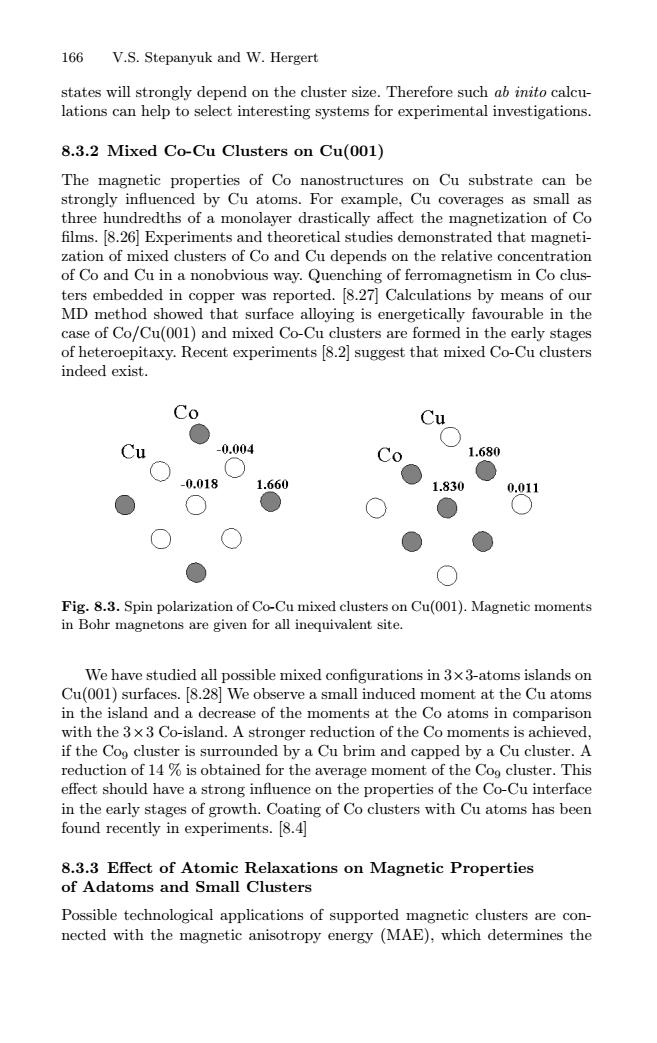正在加载图片...

166 V.S.Stepanyuk and W.Hergert states will strongly depend on the cluster size.Therefore such ab inito calcu- lations can help to select interesting systems for experimental investigations. 8.3.2 Mixed Co-Cu Clusters on Cu(001) The magnetic properties of Co nanostructures on Cu substrate can be strongly influenced by Cu atoms.For example,Cu coverages as small as three hundredths of a monolayer drastically affect the magnetization of Co films.[8.26 Experiments and theoretical studies demonstrated that magneti- zation of mixed clusters of Co and Cu depends on the relative concentration of Co and Cu in a nonobvious way.Quenching of ferromagnetism in Co clus- ters embedded in copper was reported.8.27]Calculations by means of our MD method showed that surface alloying is energetically favourable in the case of Co/Cu(001)and mixed Co-Cu clusters are formed in the early stages of heteroepitaxy.Recent experiments 8.2 suggest that mixed Co-Cu clusters indeed exist. Cu Cu -0.004 Co 1.680 0.018 1.660 1.830 0.011 Fig.8.3.Spin polarization of Co-Cu mixed clusters on Cu(001).Magnetic moments in Bohr magnetons are given for all inequivalent site. We have studied all possible mixed configurations in 3x 3-atoms islands on Cu(001)surfaces.[8.28]We observe a small induced moment at the Cu atoms in the island and a decrease of the moments at the Co atoms in comparison with the 3x 3 Co-island.A stronger reduction of the Co moments is achieved, if the Cog cluster is surrounded by a Cu brim and capped by a Cu cluster.A reduction of 14 is obtained for the average moment of the Cog cluster.This effect should have a strong influence on the properties of the Co-Cu interface in the early stages of growth.Coating of Co clusters with Cu atoms has been found recently in experiments.8.4 8.3.3 Effect of Atomic Relaxations on Magnetic Properties of Adatoms and Small Clusters Possible technological applications of supported magnetic clusters are con- nected with the magnetic anisotropy energy (MAE),which determines the166 V.S. Stepanyuk and W. Hergert states will strongly depend on the cluster size. Therefore such ab inito calculations can help to select interesting systems for experimental investigations. 8.3.2 Mixed Co-Cu Clusters on Cu(001) The magnetic properties of Co nanostructures on Cu substrate can be strongly influenced by Cu atoms. For example, Cu coverages as small as three hundredths of a monolayer drastically affect the magnetization of Co films. [8.26] Experiments and theoretical studies demonstrated that magnetization of mixed clusters of Co and Cu depends on the relative concentration of Co and Cu in a nonobvious way. Quenching of ferromagnetism in Co clusters embedded in copper was reported. [8.27] Calculations by means of our MD method showed that surface alloying is energetically favourable in the case of Co/Cu(001) and mixed Co-Cu clusters are formed in the early stages of heteroepitaxy. Recent experiments [8.2] suggest that mixed Co-Cu clusters indeed exist. Fig. 8.3. Spin polarization of Co-Cu mixed clusters on Cu(001). Magnetic moments in Bohr magnetons are given for all inequivalent site. We have studied all possible mixed configurations in 3×3-atoms islands on Cu(001) surfaces. [8.28] We observe a small induced moment at the Cu atoms in the island and a decrease of the moments at the Co atoms in comparison with the 3×3 Co-island. A stronger reduction of the Co moments is achieved, if the Co9 cluster is surrounded by a Cu brim and capped by a Cu cluster. A reduction of 14 % is obtained for the average moment of the Co9 cluster. This effect should have a strong influence on the properties of the Co-Cu interface in the early stages of growth. Coating of Co clusters with Cu atoms has been found recently in experiments. [8.4] 8.3.3 Effect of Atomic Relaxations on Magnetic Properties of Adatoms and Small Clusters Possible technological applications of supported magnetic clusters are connected with the magnetic anisotropy energy (MAE), which determines the